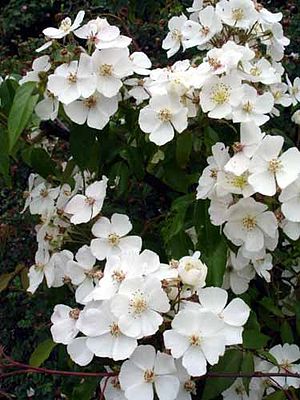Pink henryi
| Pink henryi | ||||||||||||
|---|---|---|---|---|---|---|---|---|---|---|---|---|

Pink henryi |
||||||||||||
| Systematics | ||||||||||||
|
||||||||||||
| Scientific name | ||||||||||||
| Pink henryi | ||||||||||||
| Boulenger |
Pink henryi is a species of the genus roses ( Rosa ) within the family of the rose family (Rosaceae). It is common in China and is used as an ornamental plant.
description
Appearance and leaf
Rosa henryi grows as a climbing shrub . The long, climbing shoot axes reach heights of 3 to 8 meters. The stem-round stem axes have a purple-brown bark . The shoot axes are occasionally covered with spines or they are missing. The curved spines are 3 millimeters long, flat, and gradually widen into a wide base.
The alternate leaves are arranged in a petiole and a leaf blade and are 9 to 14 centimeters long. The petiole and the rhachis leaf are sparsely spiked. The imparipinnate leaf blade usually contains five, but the leaves near the inflorescence usually contain only three leaflets. The parchment-like pinnate leaves are 3.5 to 9 centimeters long and 1.5 to 5 centimeters wide, elongated, ovate, elliptical or elliptical-ovoid with an almost rounded or broadly wedge-shaped base and a long pointed or tapered upper end. The leaf margins are simply serrated. Both leaf surfaces are bare. There is a raised median nerve on the underside of the leaflets. The stipules are fused with the petiole for most of their length. The free area of the stipules is lanceolate with a pointed upper end and a smooth edge, hairy glabrous to sparsely glandular and downy.
Inflorescence, flower and fruit
5 to 15 flowers are arranged in umbel-like, umbrella-like inflorescences , which have a diameter of 3 to 4 centimeters. The flower stalk is 1.5 to 2 centimeters and hairy short glandular-downy. The early falling bracts are lanceolate.
The fragrant and hermaphrodite flowers are 3 to 4 centimeters in diameter and have radial symmetry and five-fold with a double flower envelope . The spherical flower cup (hypanthium) is glabrous, but with short glandular and downy hairs. The five early falling sepals are lanceolate with a pointed upper end and the edge has a few leaf lobes. The underside of the sepals is almost bare and sparsely dotted with glands and the top is hairy with shaggy hair. The five free white petals bare on the outside are broadly obovate with a broad wedge-shaped base and an edged upper end. There are many stamens present. There are many free carpels . The downy, hairy styles are fused into a column, are a little longer than the stamens and protrude above the corolla.
In China, the flowering period extends from April to July and the rose hips ripen from July to September.
The rose hip, which is brown-red and shiny when ripe, is almost spherical with a diameter of 8 to 10 millimeters.
Occurrence
Rosa henryi is found in the Chinese provinces of Anhui , Fujian , Guangdong , Guangxi , Guizhou , Henan , Hubei , Hunan , Jiangsu , Jiangxi , Shaanxi , Sichuan , Yunnan and Zhejiang . It thrives on the edges of the forest in thickets or in valleys, as well as on agricultural areas at altitudes of 1700 to 2000 meters.
Systematics
Rosa henryi was discovered in China in 1907 . The first description was made in 1933 by George Albert Boulenger in Annales de la Société Scientifique de Bruxelles , Série B 53 143. synonyms for Rosa henryi Boulenger are Rosa gentiliana var. Australis Rehder & EHWilson , Pink henryi var. Australis (Rehder & EHWilson) FPMetcalf , Rosa henryi var. Glandulosa Z.M.Wu & ZLCheng , Rosa moschata var. Densa Vilm. , Rosa paucispinosa H.L.Li . The specific epithet henryi honors the Scottish plant hunter and "amateur botanist" Augustine Henry (1857–1930), who was stationed as a medical officer in Ichang .
Rosa henryi belongs to the section Synstylae from the subgenus Rosa in the genus Rosa .
Use as an ornamental plant
The climbing wild rose Rosa henryi can be planted as an ornamental plant in parks and gardens on trees or on another stable support. This once-flowering, strongly scented rose type is sensitive to frost.
Individual evidence
- ↑ a b c d e f g h Gu Cuizhi, Kenneth R. Robertson: Rosa. : Rosa henryi , p. 378 - online with the same text as the printed work , In: Wu Zheng-yi, Peter H. Raven (Ed.): Flora of China. Volume 9: Pittosporaceae through Connaraceae. Science Press and Missouri Botanical Garden Press, Beijing and St. Louis, 2003, ISBN 1-930723-14-8 .
- ^ A b Rosa henryi in the Germplasm Resources Information Network (GRIN), USDA , ARS , National Genetic Resources Program. National Germplasm Resources Laboratory, Beltsville, Maryland. Retrieved February 28, 2016.
- ↑ Jingyun Fang, Zhiheng Wang, Zhiyao Tang: Atlas of Woody Plants in China: Distribution and Climate . tape 1 . Springer, 2011, ISBN 978-3-642-15017-3 ( distribution map by Rosa henryi on page 558 in the Google book search).
- ↑ a b c d world of roses .
- ↑ Rosa henryi at Tropicos.org. Missouri Botanical Garden, St. Louis, accessed on February 28, 2016.